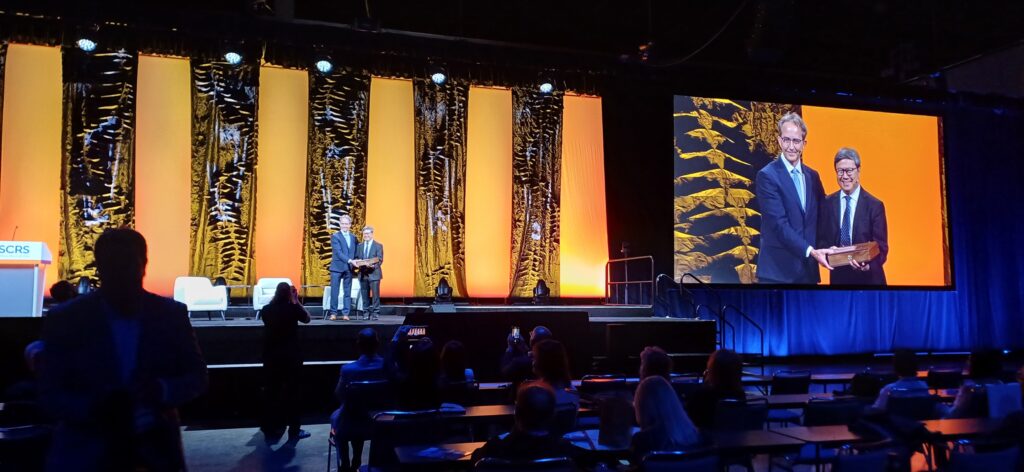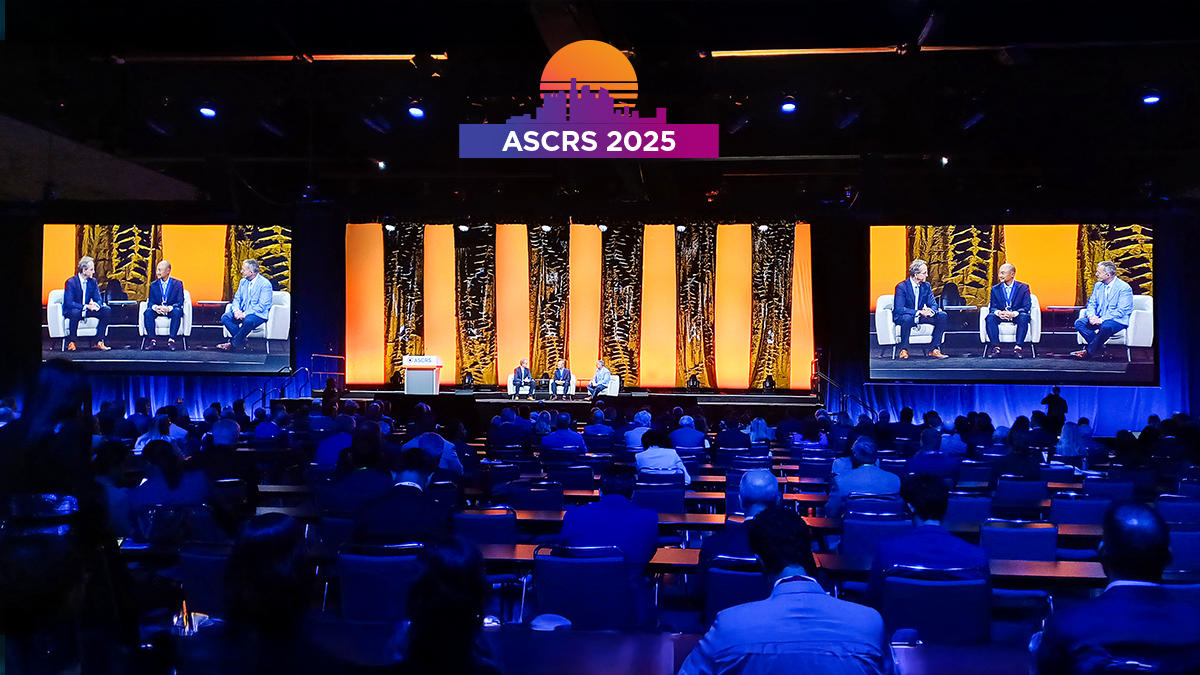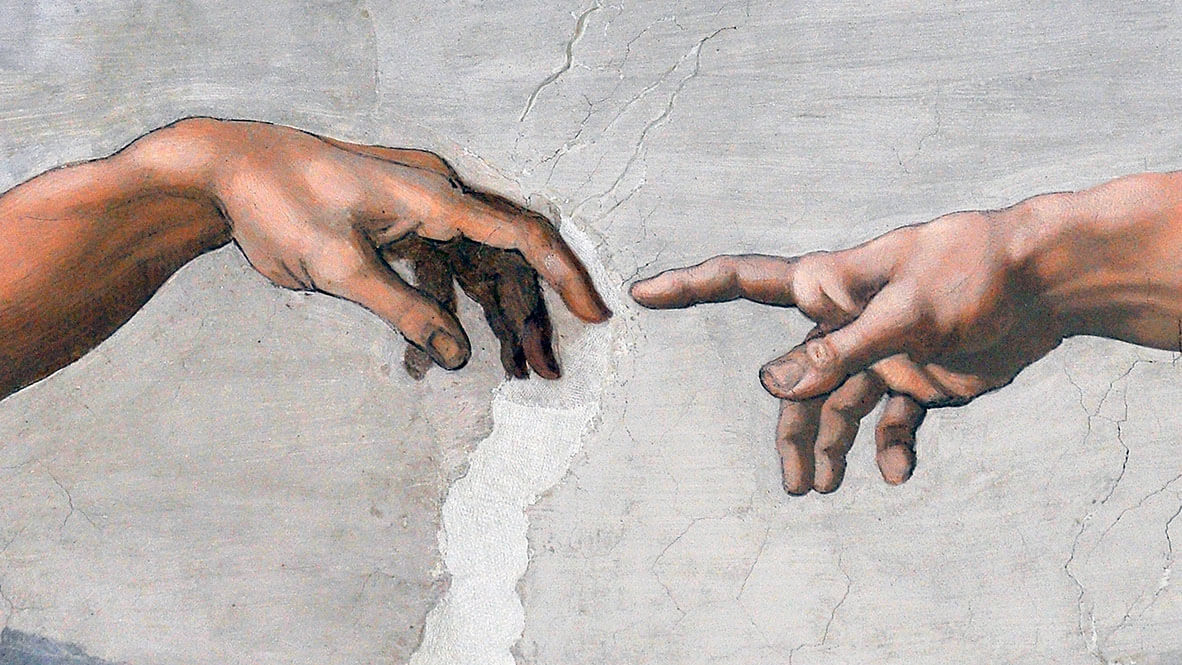From honoring both American and global stars of cataract and refractive surgery to Prof. Ronald Yeoh’s fresh look at hydrodissection in cataract surgery, it was an Opening Session for the ages.
The American Society of Cataract and Refractive Surgery 2025 Annual Meeting (ASCRS 2025) has officially opened with a bang at the Los Angeles Convention Center on Day 1 of American cataract and refractive surgery’s most storied long weekend of the year.
The Opening Session featured thoughtful reflections on global and local North American leadership in cataract surgery, including humanitarian recognition for one of Spain’s—and the world’s—key sight-saving initiatives (Chang-Crandall Humanitarian Award) and the prestigious Binkhorst Medal Lecture.
The meeting’s host city, Los Angeles, and its recovery mere months from the tragic fires that turned worlds upside-down proved to be a key source of inspiration for the Meeting, and a reminder of service in the face of extreme adversity that surgeons must face down every day in their mission to preserve sight worldwide.
READ MORE: Preventing and Treating Avoidable Blindness with Orbis Singapore
ASCRS leadership transition: From Vance Thompson to Francis Mah
The Opening Session is typically a time to acknowledge one of the biggest changes affecting the Society—the change from one president to the next.
Outgoing ASCRS President Dr. Vance Thompson (United States) reflected on his term, noting the society’s response to recent Los Angeles wildfires. “To see how thoughtful the executive council and staff were about caring for LA. I’m just so thankful for the rebound in this city,” he said.
Dr. Thompson, known for his avuncular nature and relationship-building approach, emphasized one key aspect of his tenure at the head of the organization.
“The part I’m most proud of is just the culture of this society. Here, we not only have this wonderful membership, but we also have the industry that supports us and our international colleagues that care about us,” Dr. Thompson remarked. “To see all these things come together and have a front row seat to it has been an absolute honor.”
Incoming President Dr. Francis Mah (United States) gave audiences a sneak peek of his vision for the presidency. Among the components of this vision, Dr. Mah identified government relations as a priority. “I really want the younger ophthalmologists to get involved in government relations,” he stated, emphasizing the importance of “paying it forward” to future generations. He also expressed the importance of support for expanding the foundation’s mission work, mentioning upcoming trips to Armenia and Nepal.
Chang-Crandall Humanitarian Award

Speaking of paying it forward, the evening’s first awardee, Dr. Elena Barraquer (Spain), took to the Main Stage to receive the Chang-Crandall Humanitarian Award, which included a $100,000 donation to a charitable organization of the recipient’s choice.
Dr. Susan MacDonald (United States), ASCRS Foundation Chair, presented the award, explaining that it was established in 2017 to recognize outstanding humanitarian work in the field of cataract blindness and disabilities. The award was renamed in 2020 to honor Dr. Alan Crandall’s exemplary commitment to humanitarian service.
The Elena Barraquer Foundation has provided care for over 124,000 people in more than 20 countries, with volunteer surgeons performing over 21,000 pro bono cataract surgeries, conducting more than 50,000 medical consultations, and delivering over 65,000 glasses.
“Even though I always say that the best reward is the smile of our patients when they realize they can see again, this comes very close to it,” Dr. Barraquer said in her acceptance speech.
She thanked her team in Barcelona and the many volunteers who have made the foundation’s work possible, as well as her father and grandfather who taught her “to treat not only the people who could pay me back, but especially the people who could not, because they were the ones most in need.
Hall of Fame induction
ASCRS legend and key Society cornerstone, Dr. Richard Lindstrom (United States), was then inducted into the ASCRS Ophthalmology Hall of Fame for his contributions spanning over 25 years. Dr. Edward Holland (United States), Hall of Fame chair, detailed Dr. Lindstrom’s impact as “a researcher, surgeon, investigator, teacher, inventor, mentor and leader” who has “profoundly affected a generation of ophthalmology in several subspecialties.”
Dr. Lindstrom’s role has been in advancing ophthalmology by breaking down barriers to synergizing with industry, echoing in part Dr. Thompson’s remarks. “He changed the paradigm for industry and clinical interaction, breaking down long-held biases that this kind of activity was somehow wrong or unethical,” said Dr. Holland. “He showed us the way for meaningful collaboration between clinicians and companies that resulted in better drugs, better devices and better outcomes for our patients.”
Dr. Lindstrom’s career includes over 400 published papers, 45 patents in ophthalmology and development of numerous ophthalmic devices still in clinical use. His fellowship program has trained more than 80 specialists, and he has served as president of multiple ophthalmology organizations, including ASCRS.
READ MORE: AI Tools in Ophthalmology at ASCRS 2025
Dr. Tom Samuelson (USA), Dr. Lindstrom’s practice partner for 34 years, provided a personal perspective, describing him as having “an extraordinary combination of attributes. He’s powerful, but gentle. He’s assertive yet kind. He’s intellectual yet relatable. He’s academic yet strategic. He’s pragmatic yet innovative.”
“For 47 years, ASCRS has been my guiding light in practice management, patient care and interaction with industry. Most importantly, it’s been a source of extraordinary friendships,” Dr. Lindstrom said in closing as he accepted his place among the greats of American cataract and refractive surgeons.
Binkhorst Medal Lecture: Three decades of hydrodissection technique
The academic centerpiece of the opening ceremony, as in years past, was the Cornelius D. Binkhorst Medal Lecture, delivered by Prof. Ronald Yeoh (Singapore).
Dr. Samuelson introduced Prof. Yeoh as someone who “has left an indelible signature on international ophthalmology,” noting his dedication to teaching and his numerous awards, including 20 best film awards at cataract society meetings worldwide.
Prof. Yeoh’s presentation, “A 30-Year Love Affair with Hydrodissection,” examined what he acknowledged isn’t a “glamorous or sexy” topic but one that is critically important despite taking only about ten seconds to perform during cataract surgery.

READ MORE: Cataract Surgery: Enhancing the Patient’s Experience
“Hydrodissection is a step that takes all of us barely ten seconds, but its importance is actually disproportionate to the amount of time taken for the procedure—and also the number of words actually written about it in the textbooks.”
Prof. Yeoh began with his discovery of the “pupil snap sign” 32 years ago when performing hydrodissection through the side port. “When I hydro-dissected through the side port, the pupil snapped. I knew something had happened,” he explained.
This led to his realization that this sudden pupil constriction signaled posterior capsule rupture from excessive fluid pressure. “It’s a form of intraoperative capsular block,” he noted, “and if you think about it, what happens to the fluid? When we inject, the fluid either goes around completing hydrodissection or it collapses the nucleus forward or, God forbid, you rupture the posterior capsule.”
One of the lecture’s highlight components came when Prof. Yeoh presented intraoperative optical coherence tomography (OCT) imaging of hydrodissection. “This was the first time I think anyone had ever seen hydrodissection seen from the side,” he said, demonstrating how the fluid wave creates a gap behind the nucleus and lifts it up.
“This technology is very useful in helping me understand the real hydrodynamics of hydrodissection,” he explained, showing how gentle versus rapid injection techniques affect the fluid dynamics.
Prof. Yeoh systematically outlined five key indicators of a successful hydrodissection:
- The fluid wave traveling across the lens
- The nucleus coming forward (nucleus lift sign)
- The push-back sign when the nucleus rebounds after compression
- Pupil enlargement
- Cortical splitting
He also lovingly addressed his struggles with achieving Howard Fine’s cortical cleaving hydrodissection which theoretically eliminates the need for cortical cleanup. After surveying 20 leading cataract surgeons worldwide, Prof. Yeoh found that 90% “rarely or never” achieved complete cortical cleavage, attributing this to persistent cortical-capsular adhesions that channel the fluid to deeper layers rather than the subcapsular space.
Prof. Yeoh also discussed hydrodelamination, a related technique involving perinuclear injection to free just the nucleus, particularly useful in polar cataracts and soft nuclei. OCT imaging revealed how this creates the characteristic “golden rings” while completely isolating the nucleus.
A significant portion of the lecture addressed complications, particularly iris prolapse during intraoperative floppy iris syndrome (IFIS). Prof. Yeoh also demonstrated a particularly innovative technique developed by Dr. Ishtiaque Anwar from Bangladesh that involves placing a phaco sleeve around the hydrodissection cannula.
“The rationale is that when you’re doing hydrodissection with this, the buildup of fluid is prevented. You don’t allow the fluid to build up behind the iris causing the prolapse. The fluid exits around the phaco sleeve, and the very presence of the phaco sleeve actually tamponades the incision and holds the iris back,” Prof. Yeoh explained.
Prof. Yeoh was also keen to point out hydrodissection’s continued relevance in contemporary practice, particularly with the increasing prevalence of needle-stick cataracts from intravitreal injections and laser vitreolysis.
“With every Tom, Dick and Harry giving intravitreal injections, we are all seeing an upsurge in the number of needle-stick cataracts with these waterlogged cataracts,” he noted, advising surgeons to approach these cases with the same caution as posterior polar cataracts.
And in a personal conclusion that summoned some unexpected Hollywood flair, Prof. Yeoh referenced his sister Michelle Yeoh’s Oscar win in Los Angeles two years ago for “Everything Everywhere All at Once”.
“At the time she got this award, I think none of us in the family could even begin to imagine what it must have felt like to her to reach this pinnacle in her career,” he said.
“But today, thanks to ASCRS awarding me the Binkhorst Medal Lecture, I’ve reached the pinnacle of my career, and I begin to understand a little bit of how Michelle must have felt.”
READ MORE: Get the freshest updates from ASCRS 2025—follow our daily coverage here.
Editor’s Note: Reporting for this story took place during the annual meeting of the American Society of Cataract and Refractive Surgery (ASCRS 2025) being held from 25-28 April in Los Angeles, California, United States.



